Using the Small Magnetic Loop Antenna (SMLA) to Reduce the Electrostatic Noise My Neighborhood Generates
All amateur radio antennas are full of compromises. No exceptions. The small magnetic loop antenna's main compromise is that it trades low gain reception of RF signals for lowered susceptibility of electrostatic interference.
The end result is that you can better hear the weak ones, even if you live in a noisy electrostatic environment. The SMLA is also somewhat directional, as it captures less RF and RFI energy located broadside to it.
Here is why I like SMLAs.
MY CONTEXT
When I first moved to my present QTH, back in 1987, our nearest neighbors were thousands of feet away. Most were elderly. There were no plasma TVs then, nor were there any of those cheap electronic gadgets - internet of things (IoT) - people buy nowadays to make their house "easier" to live in!
As a result, electrostatic and electromagnetic interference has dramatically increased in recent years at my QTH.
Clusters of condos have sprung within a few hundred feet from our house. Twenty condos in all, inhabited by well-off baby boomers, with lots of money to spend on all the above-mentioned interference-generating electronic gadgets. I'm surrounded... but not surrendering!
My 124 feet long inverted 'L' is picking up a prohibitive amount of RFI to the point that I can tell when my neighbors go to bed! My background noise usually drops by two to three 'S' units or more by the time most of them are asleep.
That means that I would have to operate after midnight to get away from the RFI noise! I'm not getting any younger. Therefore that doesn't appeal to me at all. I need my beauty sleep!
An SMLA helps pull QRP signals up by lowering the noise floor.
To make a long story short, I decided to explore the capabilities of small mag loop antennas (SMLA) to hopefully make my HF receiving more enjoyable. One of the most appealing characteristics of SMLAs is that they do not capture much energy in the electric field. Instead, they respond very well to electromagnetic energy. But, due to their small size compared to the wavelength being received, they exhibit less gain than a half-wavelength dipole for the same wavelength.
In other words, the SMLA delivers much better signal-to-noise (S/N) ratios than more conventional antennas such as dipoles, verticals and long wires... which helps pull QRP signals out of the resulting lowered noise floor.
THE SMLAs I EXPERIMENTED WITH
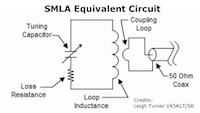
Small mag loop antennas fall under two major categories:
- reception only
- transmit & receive
The magnetic field of a circular loop - in this case a small mag loop positioned vertically - is such that minimum signals are located broadside to the plane of the loop.
One can simply aim the flank of the loop at the offending source of interference (in the near-field range) to reduce it.
The maximum electromagnetic signals are captured off the outer perimeter, in the plane of the loop.
THE SMALL MAGNETIC LOOP ANTENNA FOR RECEPTION ONLY
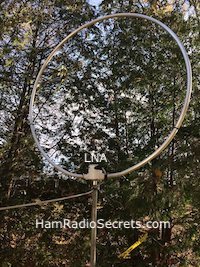 Wellbrook Active HF Loop
Wellbrook Active HF LoopThe circumference of a small magnetic loop antenna should be about one tenth (1/10) the length of the lowest frequency wavelength the antenna is intended for.
Because of its small size, the small mag loop must be of the "active" type because it does not capture as much RF energy as, for example, a half-wave dipole. In other words, it must be equipped with a (very) low-noise amplifier (LNA). If not, the receiver must have a (very) low-noise preamplifier to obtain a decent S/N ratio.
After much research and deliberations, I finally settled on the Wellbrook Ultra Low Noise Active Loop antenna - model ALA1530L which I installed outdoors (see photos). Yes, I know, it's expensive. But, man, the performance is outstanding, for lack of a better superlative!
I use an SDR receiver - an AirSpy/Spyverter combo - between the Wellbrook active SMLA and the SDRconsole software on my PC.
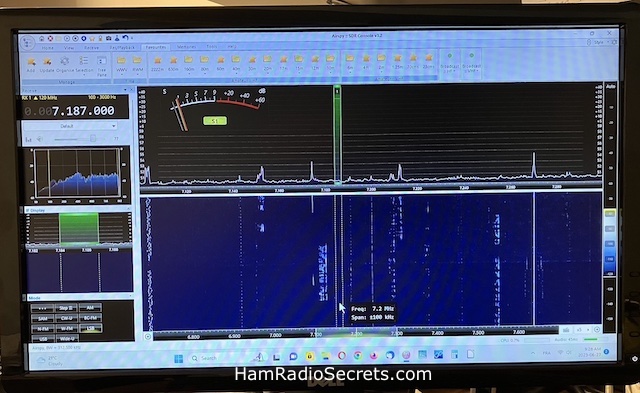
SMLAs FOR TRANSMIT-RECEIVE DUTY
Most SMLAs you will find on the market will be for QRP service (less than 10-15 watts pep). For example:
- The WonderWand Wonderloop (see photos)
- Antennas4less magloop TX/RX HF-319 by Doxytronics (max 15 watts pep) (see photos) (Unfortunately, they are no longer in business :(
- The Express Preciseloop antenna by PreciseRF, on the other hand, will allow a maximum of 45 watts PEP. (see photos)
The "low power" variety can be used as indoor magnetic loop antennas. But, keep humans and pets at a safe distance, including yourself!
Please see the following URLs for more information on this important matter of safety:
- http://www.arrl.org/rf-exposure
- http://hintlink.com/power_density.htm
There are, of course, many other commercially made SMLAs in the QRP or low power category such as the AlphaAntenna EmComm MagLoop, the AlexLoop, the MFJ magnetic loop antennas and the ones by Chameleon, to name the most popular.
A HIGHER POWER MAGNETIC LOOP ANTENNA
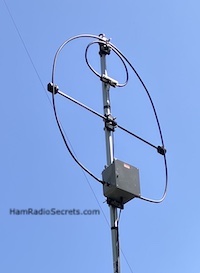 The Alpha T/R remote controlled mag loop
The Alpha T/R remote controlled mag loopI have installed the 10 to 40 Meter, remotely tuned, Alpha magnetic coaxial loop antenna made by AlphaAntenna.com (see photos). It is rated at 100 Watts PEP SSB. I switch over to it when electrostatic interference becomes objectionable on my inverted 'L' long wire. Its remote control requires some practice before you get (relatively) comfortable with it.
Why did I not choose the HG3 Stepper Mag Loop Antenna by PreciseRF.com? Because it had a minimum 3-4 weeks lead time when I was ready to order. It was also more expensive than the Alpha. Admittedly, its remote tuning technology appears more sophisticated and "user-friendly".
THE HOMEMADE OPTIONS
There are also countless DIY solutions on the Web. Here are a few links to whet your home brewer's appetite:
- https://www.w8ji.Com/magnetic_receiving_loops.htm
- https://www.aa5tb.Com/loop.html
- http://www.g4ilo.Com/wonder-loop.html
- http://vk2rh.Com/Magnetic-Loop-Antenna-Project/
Small Magnetic Loop Antenna Calculator
- https://www.66pacific.Com/Calculators/small-transmitting-loop-Antenna-calculator.aspx
- https://miguelvaca.github.io/vk3cpu/magloop.html
SUMMARY
The above was a quick overview of the small magnetic loop antenna (SMLA). SMLAs offer great signal-to-noise ratios (S/N) but their low gain require a low noise preamplifier on receive.
73 de VE2DPE
Claude Jollet
104-30 avenue des Berges,
Notre-Dame-des-Prairies, Québec, Canada J6E 1M9
QTH Locator: FN36gb
Disclosure
If
you make a purchase via a link on this site, I may receive a small
commission on the transaction, at no extra cost to you. Thank you!
(One word queries work best)
HF Antennas
Section
Contents
VHF/UHF Antennas
FOUND THIS
SITE
USEFUL?
VE2DPE
Is a member
in good standing
of
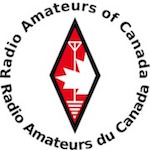

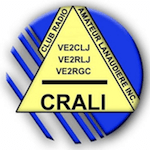
Also a proud member of an international community of solopreneurs
using SoloBuildIt!
(SBI!)
to promote my self-published eBooks
since 2005.
See my review
of this unique product for online businesses.
CQ CQ CQ
If you have a question, a comment or a topic you would like me to cover, please do not hesitate to ask here.


